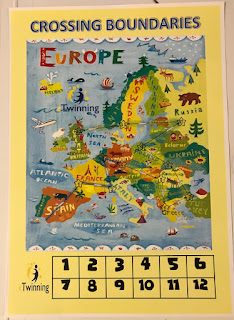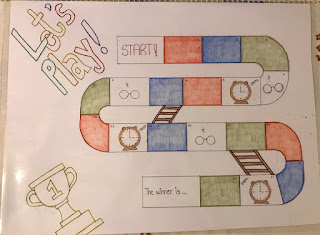In this project, my
learners have the chance to interact
with foreign students of schools of other countries which participate in
the eTwinning Platform. So, I think, it is important that students know the countries of Europe.
For this reason, this map with a route which crosses all
the Europe is hung in the English Corner. It has twelve different stops linked to the twelve Integrated Didactic
Units. Students have to complete the different tasks in the eTwinning Project in
order to move on the map. This project crosses boundaries and let my students know much more about Europe
and the different values, customs, cultures and traditions. This is what I try
to represent in this map, whose goal is to know more deeply the countries which participate in this eTwinning Platform.
And how do they “travel” across
Europe? Each
student has their own “eTwinning
Passport”, in which they have to draw the most representative aspects that they have learnt about other
countries during the eTwinning session.
But
how do I carry out the Project? For example, if the IDU is the number 11, this
information exchange has, as a main point, to talk about the most popular traditions, festivals and
festivities in their countries, establishing comparisons between Andalusian
and other cultures, which is important to develop CAE and LTL. So, each student
draws, in the corresponding page, (IDU 11), the name of the topic –traditions- and something which they have learnt
during the session; for example, the Notting Hill Carnival, one of the most
common festivities in England. This material can prompt learners’ interest and motivation towards the project.
But,
this social guide interaction…In which ways? Through the TWINSPACE by means of videos, songs,
tasks, and so on related to this topic about music (R-W skills) or through Video Conferencing, of course when it
is possible, to share information orally in a guided process (L-S skills). Obviously, my role, as an English teacher, is
to be facilitator and guide of this process. Of course, I would like to repeat
the total importance of an adequate coordination and cooperation not only among teachers of all schools
but also with the Teacher Staff in my school.
And
the last question: why do I do this? Because, as I
said before, this eTwinning Project represents a great chance to develop positive attitudes towards the
English language, since it is provided meaningful and functional communicative situations. In the
current society, prompting values such as tolerance
and respect towards other cultures is vital. And, from my point of view, there
is nothing better than students share
cultures and customs across Europe in an interactive and enjoyable way.









